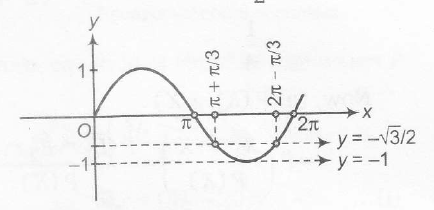Answer:
Option A,C,D
Explanation:
Concept lnvolved. It is based on range of sin x i.e., [-1,1] and the internal for a< x< b.
Description of situation As \theta, \phi \epsilon [0,2\pi] and
\tan (2 \pi-\theta) 0,-1<\sin \theta <-\frac{\sqrt{3}}{2}
\tan (2 \pi-\theta) >0 \Rightarrow -\tan \theta >0
\therefore \theta \epsilon II or IV quadrant
also, -1 < \sin \theta < -\frac{\sqrt{3}}{2}

\Rightarrow \frac{4 \pi}{3} < \theta < \frac{5 \pi}{3} but \theta \epsilon II or IV quadrant
\Rightarrow \frac{3 \pi}{2} < \theta < \frac{5 \pi}{3} .....(i)
Sol. here
2 \cos \theta (1-\sin \phi )
= \sin^{2} \theta (\tan \frac{ \theta}{2}+\cot \frac{\theta}{2}) \cos \phi-1
\Rightarrow 2 \cos \theta-2 \cos \theta \sin \phi
= \sin^{2} \theta\left(\frac{\sin^{2}\frac{\theta}{2}+\cos^{2} \frac{\theta}{2}}{\sin \frac{\theta}{2} \cos \frac{\theta}{2}}\right) \cos \phi-1
=2 \cos \theta-2 cos \theta \sin \phi
=2\sin^{2} \theta\left(\frac{1}{\sin\theta}\right) \cos \phi-1
=2 \cos \theta +1=2 \sin \phi \cos \theta+2 \sin \theta \cos \phi
\Rightarrow 2 \cos \theta+1=2 \sin ( \theta+\phi).....................(ii)
From Eq.(i)
\frac{3 \pi}{2} < \theta < \frac{5 \pi}{3} \Rightarrow 2 \cos \theta+1 \epsilon(1,2)
\therefore 1 < \sin (\theta+\phi)<2
\rightarrow \frac{1}{2} < \sin (\theta +\phi) <1......(iii)
\Rightarrow \frac{\pi}{6} < \theta +\phi < \frac{5 \pi}{6} or \frac{13 \pi}{6} < \theta +\phi < \frac{17 \pi}{6}
\therefore \frac{\pi}{6} -\theta < \phi < \frac{5 \pi}{6}- \theta
or \frac{13 \pi}{6}-\theta < \phi < \left(\frac{17 \pi}{6}\right)-\theta
\Rightarrow \phi \epsilon\left(-\frac{3 \pi}{2},-\frac{2\pi}{3}\right)or \left(\frac{2\pi}{3},\frac{7 \pi}{6}\right),
as \theta \epsilon\left(\frac{3 \pi}{2},\frac{5 \pi}{3}\right)